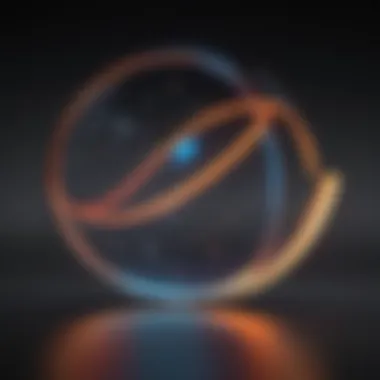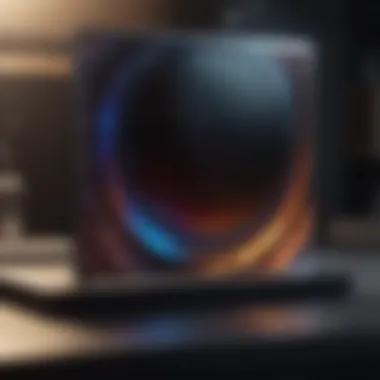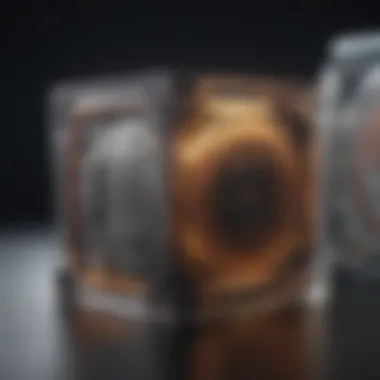In-Depth Analysis of Organic Light Emitting Diodes


Article Overview
Purpose of the Article
The purpose of this article is to take readers on a deep dive into the fascinating world of organic light-emitting diodes, commonly known as OLEDs. In the landscape of modern electronics, OLEDs are not just a passing trend; they play a crucial role in display technology and beyond. This examination aims to shed light on the fundamental principles behind OLEDs, trace their evolution, and highlight significant technical advancements. An in-depth look will also be provided on various real-world applications where OLED technology shines.
Relevance to Multiple Disciplines
Understanding OLED technology is essential for a multitude of fields. From students in physics and engineering to professionals in design and manufacturing, the insights gained here are incredibly valuable. The relationship between OLEDs and energy efficiency not only impacts consumer electronics but also touches upon sustainability efforts, making it relevant to environmental studies. Furthermore, the artistic aspects of OLEDs can intersect with disciplines like art and design, pushing the boundaries of creativity in the displays we interact with.
Research Background
Historical Context
To understand where OLEDs stand today, it’s essential to explore their historical backdrop. The concept of organic light emission originated in the 1980s, with the first practical implementation achieved by Ching W. Tang and Steven Van Slyke at Eastman Kodak in 1987. Their pioneering work laid the groundwork for commercial applications, though it was a slow climb before OLEDs made their splash in the market. Initially, the technology was faced with challenges, such as inefficiencies and short lifespan, which scientists and engineers have tackled over decades.
Key Concepts and Definitions
Before delving deeper into the technology, grasping some key concepts and terms is vital for clarity:
- Organic Materials: These are carbon-based compounds that exhibit light-emitting properties when subjected to an electric current.
- Electroluminescence: The phenomenon whereby a material emits light in response to an electric field.
- Thin-Film Technology: A fabrication method critical in producing OLED displays, allowing for compact and flexible designs.
Understanding these terms will pave the way for a more comprehensive visualization of how OLED technology functions and continues to evolve.
Foreword to Organic Light Emitting Diodes
The realm of organic light emitting diodes, commonly referred to as OLEDs, marks a significant chapter in display and lighting technology. This section serves to underscore the importance of OLED technology, which has sparked tremendous interest among researchers and industry professionals alike. Its practical applications have revolutionized how we interact with screens and lighting solutions, creating vivid visual experiences that were once thought to be the stuff of science fiction.
The distinctive features of OLEDs, primarily their ability to produce bright and vibrant images with thinner profiles and lower energy consumption, make them increasingly relevant in today's tech-driven landscape. More notably, OLEDs offer flexibility, both in physical form and application, allowing for innovative designs that enhance user experience.
Benefits of OLED Technology
- Energy Efficiency: OLEDs consume less power than traditional lighting methods and even LCDs.
- Thin Design: Their slim profile allows for sleek, lightweight devices.
- Color and Contrast: OLEDs can produce deeper blacks and a wider color range, improving overall visual quality.
- Flexibility: These diodes can be incorporated into various surfaces, increasing design possibilities.
Considerations About OLEDs
While the prospects of OLED technology paint a bright picture, certain considerations warrant attention. For instance, the longevity of OLEDs in comparison to conventional LEDs can be a double-edged sword. Although they deliver excellent picture quality, their durability is often challenged by factors like heat and moisture. This brings us to acknowledge the importance of ongoing research to improve materials and methods in OLED production. Emphasizing the balance between advantages and limitations is essential in appreciating OLED's pathway forward.
What Are OLEDs?
Organic Light Emitting Diodes (OLEDs) are a type of electroluminescent display technology that utilizes organic compounds to emit light when an electric current is applied. Unlike traditional LEDs, which rely on inorganic materials, OLEDs use carbon-based substances, which allows for more flexible and thinner construction.
The structure of an OLED typically includes several layers, namely the organic layer containing the light-emitting compounds, sandwiched between two conductive layers, often made of metals. This arrangement enables electrons and holes to recombine in the organic layer, emitting photons—essentially, light.
"OLED technology represents a leap forward in display quality, inciting creativity in how we think about screens and lighting solutions."
"OLED technology represents a leap forward in display quality, inciting creativity in how we think about screens and lighting solutions."
The simplicity of their design has prompted their adoption in diverse applications, from smartphones and televisions to emerging technologies in lighting solutions. OLEDs have positioned themselves as a viable alternative to their LED counterparts, carving out a niche where high performance and aesthetics collide.
Historical Context and Evolution
To fully grasp the significance of OLEDs today, it's crucial to delve into their historical context and evolution. The journey of OLED technology began in the 1980s, when scientists identified the potential of organic materials for light emission. The initial breakthrough came in 1987 when researchers like Ching W. Tang and Steven Van Slyke at Eastman Kodak developed the first practical OLED.
As the years rolled on, advancements in materials and manufacturing processes enabled the production of larger displays and more efficient light sources. The shift from monochrome to full-color displays was a game changer—thanks in large part to the integration of blue, green, and red emitting materials.
Today, OLED technology has evolved into a cornerstone of modern display solutions, widely used in consumer electronics. The continued emphasis on innovation ensures that OLEDs will adapt and evolve, meeting the demands of increasingly dynamic technological landscapes.
In summary, the exploration of OLEDs opens up a multifaceted discussion about their makeup, capabilities, and the pivotal role they play in modern technology. As we proceed further into the analysis, we will uncover the fundamental principles, materials, and future trends that additionally characterize this fascinating domain.
Fundamentals of OLED Technology
Understanding the fundamentals of organic light emitting diodes (OLEDs) is essential as it lays the groundwork for comprehending the intricacies of this technology. OLEDs have become increasingly prominent in various applications, such as displays in smartphones, TVs, and innovative lighting solutions. The significance of this section goes beyond mere technical jargon; it seeks to unravel the fundamental principles that make OLEDs efficient and appealing.
The basic structure and operational mechanisms of OLEDs offer a peek into how these devices generate light and provide a platform for advancements in the field. Grasping these concepts also equips students, researchers, and professionals with the knowledge necessary to appreciate the advantages and potential challenges associated with OLED technology.
Basic Structure and Components
At first glance, the structure of an OLED might seem deceptively simple. However, it's a carefully designed assembly that works in harmony to produce vibrant light. An OLED is primarily composed of several vital layers, each playing a distinctive role in its operation:
- Substrate: The foundation of the OLED, usually made from glass or flexible plastic. This substrate supports the OLED stack and can impact its durability and performance.
- Anode: A key player in the light emission process, the anode is typically made from transparent materials, which allows light to escape efficiently.
- Organic Layers: These are the heart of the OLED—two essential layers are involved:
- Cathode: Positioned at the back, the cathode injects electrons into the OLED structure, enabling light emission to occur when it interacts with the holes.


- Hole Transport Layer (HTL): This layer allows positively charged holes to travel from the anode towards the emissive layer.
- Emissive Layer (EML): Here, the magic happens. Electrons from the cathode combine with holes in this layer, leading to light production when they return to a lower energy state.
This multi-layered construction is what makes OLEDs unique and efficient. By contrast, traditional light sources use bulky components that can lead to energy waste, while OLEDs can be thin and flexible, making them exceptionally versatile.
Mechanisms of Light Emission
At the core of OLED operation lies the mechanism of light emission, a process that requires the coordination of functions among all layers. When a voltage is applied, electrons are pushed from the cathode, while holes flow from the anode. This delicate dance of charges happens through specific interactions and energy states involved in the organic materials used.
The critical stages can be summarized as follows:
- Charge Injection: Upon applying a voltage, electrons travel from the cathode into the emissive layer, while holes, facilitated by the HTL, move towards the emissive layer from the anode.
- Charge Transport: As electrons and holes approach one another, they move through their respective layers—each layer engineered to enhance mobility, ensuring the charges arrive promptly at the emissive layer.
- Recombination: When an electron and a hole meet within the emissive layer, they recombine, releasing energy in the form of light. Depending on the materials used in this layer, the emitted light can appear in different colors, providing flexibility in the design of displays and lighting systems.
- Light Emission: The final step is the escape of light through the transparent anode, illuminating the surroundings. This whole process is remarkably efficient, leading to lower energy consumption per brightness level in comparison to other lighting technologies.
"When understanding OLEDs, one must recognize the harmony among structure, function, and efficiency, which drives innovations in displays and beyond."
"When understanding OLEDs, one must recognize the harmony among structure, function, and efficiency, which drives innovations in displays and beyond."
In summary, a solid grasp of the fundamentals of OLED technology is instrumental for anyone keen on diving deeper into the subject. The combination of its unique structure and the intricate mechanisms that allow for light production positions OLEDs at the forefront of display and lighting advancements.
Materials Used in OLEDs
The use of specific materials in organic light-emitting diodes (OLEDs) is crucial for their functionality and performance. Understanding these materials not only sheds light on how OLEDs work but also pinpoints the efficiencies and potential shortfalls in current applications. This section will explore the two primary categories of materials in OLED technology: organic semiconductors and inorganic components. Together, these elements create the vibrant displays and lighting solutions we see today.
Organic Semiconductors
Organic semiconductors are the heart and soul of OLED technology. Generally composed of carbon-based molecules, these materials exhibit the unique ability to conduct electricity while maintaining insulating properties. This dual functionality enables them to emit light when an electric current passes through.
A few characteristics make organic semiconductors immensely valuable:
- Broad spectrum of colors: By varying the chemical structure, scientists can create organic materials that emit different colors of light, from the vibrant blues to deep reds. This versatility allows for the production of displays with a full range of colors, greatly enhancing viewer experiences.
- Flexible application: The ability to print organic semiconductors on flexible substrates means OLEDs can be woven into various forms, such as curved screens or even wearable technology. This characteristic opens doors to innovative designs that traditional display technologies might struggle to achieve.
- Lower production energy: Unlike conventional LEDs, which require substantial energy input for production, organic semiconductors can be synthesized under milder conditions. This energy efficiency during manufacturing is critical for reducing the overall carbon footprint of OLED devices.
One exemplary organic semiconductor is PTCDI (N,N'-bis(2-ethylhexyl)-2,7-carbazole). This compound efficiently generates blue light and is notable for being used in various commercial OLED products. The continuing research in this area involves improving charge transport properties to further enhance device efficiency.
Inorganic Components and Their Role
While organic materials are their mainstay, inorganic components also play a pivotal role in optimizing OLED technologies. These elements are incorporated into OLED designs to enhance performance and stability. Often, this involves compounds that help in the charge transport process, ensuring the longevity and robustness of the devices.
Here are some key functions served by inorganic materials in OLEDs:
- Enhancing stability: Inorganic components often serve to reinforce the OLED structure. Materials like Iridescent Zinc Oxide (ZnO) are utilized to stabilize the organic layers and provide a barrier to moisture that could otherwise degrade performance over time.
- Improving efficiency: Semiconducting oxides, such as Indium Tin Oxide (ITO), are commonly used as transparent conductive electrodes. Their primary task is to allow light emission while facilitating efficient charge injection, which is crucial for the effective operation of OLED displays.
- Facilitating heat dissipation: Certain inorganic materials help distribute heat generated during operation. By managing thermal levels, these materials enable OLEDs to maintain consistent brightness without compromising their lifespan.
It’s evident that while organic semiconductors steal the show in terms of light emission, inorganic components play supportive yet crucial roles. Their integration enhances durability and functionality, allowing OLEDs to perform at their best.
Understandably, the choice of materials can make or break OLED technology, as they determine the device's practicality and effectiveness across various applications.
Understandably, the choice of materials can make or break OLED technology, as they determine the device's practicality and effectiveness across various applications.
In exploring both organic and inorganic components, the ongoing evolution of OLED technology can be appreciated more profoundly, setting the stage for future innovations that build upon this intricate foundation.
Types of OLEDs
Understanding the different types of organic light emitting diodes (OLEDs) is crucial for grasping their applications and technological advancements. OLEDs are categorized primarily into two types based on their driving mechanism: Active Matrix OLEDs (AMOLEDs) and Passive Matrix OLEDs (PMOLEDs). Each type holds its unique significance, advantages, and aspects that are conducive to various use cases. This differentiation not only aids in the design of displays and lighting solutions but also affects the performance and efficiency of these devices, so distinguishing them becomes essential.
Active Matrix OLEDs
Active Matrix OLEDs, often abbreviated to AMOLEDs, represent a leap forward in display technology, primarily because they allow for sharper and clearer images. This type of OLED utilizes a grid of thin film transistor (TFT) technology to control individual pixels. Unlike other display types that rely on a simple matrix, AMOLEDs can quickly refresh each pixel independently. This creates deep blacks and vibrant colors, enhancing the overall viewing experience. Because each pixel emits its own light, AMOLED displays are notably energy-efficient compared to traditional LCDs, especially when displaying darker images.
Some notable advantages include:
- Higher resolution: Due to the ability to control pixels individually, AMOLED displays support higher pixel densities, making them ideal for smartphones and high-definition televisions.
- Thin profile: The use of thin film technology results in sleeker designs, ideal for portable devices.
- Faster refresh rates: This makes them particularly well-suited for gaming and action-packed video content.
However, there are challenges:
- Burn-in issues: Prolonged use of static images can lead to screen burn-in, affecting longevity.
- Cost: The manufacturing process for AMOLED screens is typically more complex and costly than their passive counterparts.
Passive Matrix OLEDs
On the other hand, Passive Matrix OLEDs are often regarded as simpler and cost-effective alternatives. PMOLED technology utilizes a straightforward and less expensive structure, in which rows and columns of the pixel matrix are driven by scanning methods. While this can be a great choice for specific applications, PMOLEDs come with their own set of limitations.
Their strengths lie in the following:
- Budget-friendly: These displays are easier to produce, making them an attractive choice for low-cost applications like small screens in appliances and basic wearables.
- Lower power consumption in certain applications: When displaying simple graphics or text, PMOLEDs can be quite efficient compared to their active counterparts.


Nevertheless, PMOLEDs also experience drawbacks:
- Limited scalability: The resolution and size are generally limited due to the scanning methodology, making them unsuitable for larger, high-density screens.
- Slower refresh rates: This can result in ghosting effects, particularly noticeable when displaying fast-moving images.
"As technology advances, the boundaries of OLED applications keep expanding, leading to innovative uses that make both types increasingly important."
"As technology advances, the boundaries of OLED applications keep expanding, leading to innovative uses that make both types increasingly important."
By recognizing these types of OLEDs, researchers and developers can make informed decisions and optimize for performance in future deployments.
Advantages and Disadvantages of OLED Technology
The exploration of organic light emitting diodes (OLEDs) necessitates a thorough understanding of their advantages and disadvantages. These are not mere technical features; they have direct implications for consumers, manufacturers, and the broader field of display and lighting technology. By dissecting these elements, we can appreciate why OLEDs have gained traction in contemporary applications, while also being mindful of the challenges that accompany their adoption. Such a balanced examination supports the broader dialogue around innovation and sustainability in technology.
Key Benefits of OLEDs
OLED technology boasts a myriad of benefits that draw interest from various sectors. Here are some pivotal advantages:
- Superior Image Quality: OLEDs deliver exceptional visual experiences, offering deeper blacks and more vibrant colors. This high contrast ratio stems from their ability to turn off individual pixels completely, creating stunning images that pop.
- Thin and Flexible Design: Unlike traditional display technologies, OLEDs can be manufactured in very thin layers. This characteristic allows for the development of bendable and even rollable screens, paving the way for innovative designs in devices like smartphones and televisions.
- Wide Viewing Angles: OLED displays maintain consistent color accuracy and brightness across various angles. Whether you are seated directly in front or off to the side, the viewing experience remains relatively unchanged, unlike certain LCD displays that can wash out or distort colors from an angle.
- Faster Response Times: OLEDs respond swiftly to changes in input, which is a boon for applications requiring rapid refresh rates, such as gaming or high-speed video. The reduced motion blur enhances the overall experience in these scenarios.
- Energy Efficiency: When displaying darker images, OLEDs consume less power than traditional LCDs. This efficiency can lead to longer battery lifespans in portable devices, an essential factor for today's on-the-go lifestyles.
"OLEDs shine not just in performance, but in the potential they hold for future innovations. Their advantages shape how we interact with screens daily."
"OLEDs shine not just in performance, but in the potential they hold for future innovations. Their advantages shape how we interact with screens daily."
Challenges and Limitations
Despite their impressive benefits, OLEDs come with their fair share of drawbacks. Understanding these limitations is crucial for a balanced view:
- Burn-In Issues: One of the most persistent challenges with OLED technology is the risk of burn-in, where static images can create ghost-like impressions on the display over time. This can be particularly troublesome for users who often display the same logos or content.
- Shorter Lifespan of Blue Pixels: Blue OLEDs tend to degrade faster than their red and green counterparts. This difference can lead to color imbalances over time, affecting the overall quality of the display.
- Higher Production Costs: The manufacturing process for OLEDs can be more costly compared to traditional displays. As a result, products using OLED technology often carry a higher price tag, potentially limiting their accessibility for the average consumer.
- Limited Brightness: While OLEDs excel in contrast ratio, they can struggle in terms of peak brightness compared to some LCD technologies. This limitation may hinder their performance in well-lit environments, where bright conditions are necessary.
- Temperature Sensitivity: OLED materials can be sensitive to heat, which may impact their overall stability and performance. Operating in high-temperature environments can pose risks to longevity.
In assessing the advantages and disadvantages of OLED technology, one gains insight not only into the technology itself but also into the directions for future research and development. Understanding these facets allows consumers and industry stakeholders alike to make informed decisions as OLEDs continue to evolve.
Current Applications of OLED Technology
When it comes to organic light emitting diodes (OLEDs), their current applications reveal just how far this technology has come. OLEDs are not merely a futuristic concept; they are already carving out their place in various industries with real-world utility. This section dives into the most significant applications of OLED technology today, particularly in display technologies and lighting solutions. Understanding these usages is crucial since they showcase the benefits and considerations that OLEDs bring to the table.
Display Technologies
Display technology is arguably the most prominent application of OLEDs. Various devices use OLEDs to leverage their unique characteristics. The vibrant colors and deep blacks make them a coveted choice across several platforms.
Smartphones
In the realm of smartphones, OLED displays have transformed the user experience. They provide astonishing color accuracy and contrast ratios that make images pop like never before. The key characteristic of OLED screens in smartphones is their ability to produce true blacks because individual pixels can turn off completely. This feature not only enhances visual quality but also contributes to energy efficiency since black pixels consume less power.
However, there's a catch. The organic materials used in OLEDs may degrade over time, especially when subject to blue light emissions. While many manufacturers have developed technologies to mitigate these effects, users must be cautious about screen burn-in issues. Nonetheless, the immersive experience and energy savings solidify OLEDs as a top choice in smartphone technology.
Televisions
Television sets have also embraced OLED technology with open arms. The main selling point here is the breathtaking picture quality OLED can deliver. With high dynamic range (HDR) capabilities and an expansive color gamut, it makes watching shows and movies feel incredibly lifelike. Another significant aspect is the ultra-slim form factor, allowing for sleek designs that integrate easily into modern living spaces.
While the advantages are plentiful, one must consider the cost factor. OLED TVs can be pricier than their LCD counterparts, which may deter some consumers. Still, enthusiasts often argue that the investment is justified by the quality of the viewing experience.
Monitors
When it comes to monitors, particularly for creativity and professional work, OLED has made a memorable mark. Designers and artists adore the vivid colors and wide viewing angles that OLED panels provide. This characteristic is vital for tasks that require color precision and accuracy. Moreover, due to its quick response time, it is becoming more popular in gaming monitors as well.
However, it’s important to note that the durability of OLED monitors can be a concern. Prolonged use without protection can still lead to burn-in problems. Still, the advantages of stunning visuals often outweigh perceived drawbacks, making OLED monitors a growing favorite among creative professionals and gamers alike.
Lighting Solutions
OLEDs are also finding applications in lighting solutions, from general illumination to decorative settings. Their flexibility and thinness open up new avenues for design, migrating beyond the traditional geometrical forms that LED and fluorescent lights are often confined to.
General Lighting
In general lighting, OLED panels can create ambient light that’s soft and comfortable to the eyes. This is particularly beneficial in environments meant for relaxation or focus, such as homes and offices. The key characteristic here is the diffuse light emitted by the panels, which offers a more even light spread compared to traditional light sources.
Furthermore, OLED lighting can be incredibly energy efficient, often resulting in lowered energy costs over time. However, the initial setup can be high, and the durability of the panels is still a topic of discussion among manufacturers and consumers alike.
Decorative Applications
When it comes to decorative applications, OLED lighting shines by taking on unique shapes and configurations that can blend seamlessly into any design scheme. For instance, lamps and wall fixtures can be crafted using OLED technology to act as art rather than just functional elements. This aspect allows for innovative interior designs that captivate attention.


A downside, however, is the concern about brightness. While OLEDs can deliver stunning visuals, they may not always provide sufficient lumens for practical purposes, particularly in large rooms. Still, their aesthetic appeal makes them a desired choice for those looking to make a statement in their decor.
"The future of OLED technology is bright, but it requires continual innovation to address its challenges."
"The future of OLED technology is bright, but it requires continual innovation to address its challenges."
In wrapping up this section, it’s clear that OLED technology plays a substantial role in modern displays and lighting solutions. With their distinct advantages, they have carved a niche for themselves, yet the challenges they face require ongoing attention. Understanding how and where OLEDs can be applied helps illuminate their potential for the future.
Future Trends in OLED Technology
The trajectory of organic light emitting diodes (OLEDs) paints a fascinating picture of how technology can evolve to meet future needs. As we step further into the digital age, the relevance of OLED technology becomes apparent across multiple sectors. The continuing advancements in materials and processes hold the key to enhancing OLED performance, while the exploration of new applications promises a broader impact beyond traditional display lighting.
Advancements in Materials and Processes
In the cellophane world of OLEDs, materials play a crucial role in determining performance and longevity. Recent innovations in organic materials suggest significant improvements in terms of efficiency, stability, and color range.
- New Organic Semiconductors: Researchers are experimenting with novel compounds that surpass the efficiency of earlier materials. For instance, recent developments in non-fullerene acceptors can potentially reduce energy losses during light emission. More excitingly, these semiconductors often feature better thermodynamic properties, further extending their lifespan.
- Flexible Substrates: As technology progresses, the push towards flexible OLEDs has gained traction. These flexible substrates open avenues for applications in wearable tech and even curved screens. By integrating OLEDs with various forms of substrates, manufacturers can create novel product designs that merge functionality with creativity.
- Printing Techniques: Printing OLEDs instead of being precision-engineered offers inroads into cost reduction and scalability. Techniques such as inkjet printing or roll-to-roll processing are at the forefront of this revolution.
These advancements highlight the importance of continuous research and development in maximizing the potential of OLED technology while addressing key challenges.
Emerging Applications Beyond Displays and Lighting
It's no longer just about seeing the latest movie on a flat screen; OLEDs are finding their way into niches that once seemed improbable. A few noteworthy applications are:
- Wearable Devices: From smartwatches to health monitors, OLEDs can contribute to energy-efficient displays, making devices lightweight and enhancing battery life. These displays not only reduce the device weight but also provide clearer visuals in various lighting conditions.
- Smart Packaging: Imagine packaging that lights up when it's opened or changes color based on environmental conditions. This innovative use of OLEDs can make consumer goods more interactive and functional.
- Automotive Applications: Car dashboards and interior designs are changing. With OLEDs providing sharper visuals and flexibility in design, they are set to redefine the user experience within vehicles.
- Art and Design: OLEDs are the new canvas for artists. The ability to integrate light within the artwork itself presents unique opportunities. Artists can create immersive experiences that engage viewers in ways traditional art forms cannot.
"The future shines brightly for OLED technology, radiating potential applications that extend far beyond lighting and basic displays."
"The future shines brightly for OLED technology, radiating potential applications that extend far beyond lighting and basic displays."
These emerging applications underscore the versatility of OLED technology, potentially revolutionizing various industries while enhancing user experience.
Through ongoing advancements and the exploration of innovative uses, OLED technology undoubtedly holds promise for a future where its impact is felt in more ways than one.
Environmental Considerations
The discussion around Organic Light Emitting Diodes (OLEDs) extends beyond their impressive display capabilities and vibrant colors. As we delve into environmental considerations, it becomes crucial to touch on the sustainability of OLED technologies. The eco-friendliness of OLEDs encapsulates a broader narrative about energy efficiency, raw material utilization, and life cycle impacts, which is essential for our future.
Sustainability of OLEDs
When examining the sustainability of OLEDs, several advantages stand out. For one, OLED technology utilizes less energy compared to traditional liquid crystal displays (LCDs). This lower energy consumption during operation results in reduced greenhouse gas emissions over time, making OLEDs a more appealing option in terms of environmental impact.
Moreover, manufacturers are increasingly focusing on organic materials which are often derived from renewable sources. This shift can potentially lessen the dependence on non-renewable fossil fuels, which is beneficial for the planet. Another vital component is that the thin-film nature of OLEDs enables lighter and thinner products, which can lead to decreased emissions in shipping and transportation.
However, sustainability is a two-edged sword. While there are benefits, there's still a need to carefully manage the environmental footprint of OLED production. Processes that involve solvents and other chemicals can lead to ecosystem harm if not properly regulated.
Recycling and End-of-Life Strategies
The end-of-life phase of OLED devices poses significant challenges. Like other electronic devices, OLEDs contain materials that can be difficult to recycle. Strategies must thus be carefully designed to address the disposal of OLED screens, which generally include toxic elements that can seep into the ground if discarded carelessly.
Efforts are underway in the industry to promote better recycling mechanisms. Current methods focus on separating organic materials from their substrates to recover reusable components. Some initiatives encourage manufacturers to take a structured approach to design products that are easier to disassemble and recycle at their end-of-life.
"Recycling offers a way to not just mitigate waste, but also to enable new life for materials that would otherwise be tossed aside."
"Recycling offers a way to not just mitigate waste, but also to enable new life for materials that would otherwise be tossed aside."
A clear example of innovation in this sector is the development of pilot programs in some countries, where collected OLED waste is repurposed into new products. This principle of circular economy holds great promise for reducing the ecological impact of OLEDs in the long term.
Finale and Future Outlook
The journey through the intricacies of Organic Light Emitting Diodes (OLEDs) leads us to a significant crossroad, where the synthesis of past achievements and future aspirations intertwines. This section underscores the significance of OLED technology, not merely as a contemporary phenomenon but as a cornerstone of advanced display and lighting solutions.
The summary of key points presented in earlier sections serves to remind us that OLEDs are not a fleeting trend. Their potential impact in various industries stands tall. From consumer electronics to architectural lighting, the versatility and superiority of OLEDs in terms of energy efficiency and design flexibility cannot be overstated.
Summary of Key Points
- Fundamental Principles: OLED technology operates through organic compounds that emit light when an electric current passes through. This has paved the way for endlessly thin, flexible displays.
- Material Advancements: Continuous research in organic semiconductors has led to enhancements in color accuracy and longevity, critical for commercial viability.
- Environmental Considerations: Addressing sustainability concerns versus the growing demand for innovative displays marks a balancing act for manufacturers.
"The true strength of OLEDs lies in their adaptability, catering to varying needs in an evolving market landscape."
"The true strength of OLEDs lies in their adaptability, catering to varying needs in an evolving market landscape."
Final Thoughts on OLED Development
As we glance toward the horizon, the future of OLED development appears promising yet challenging. Emerging applications beyond traditional displays, such as wearable technology and automotive lighting, are just a few examples of how OLEDs might redefine norms in visual technology. However, for the innovations to take root, continued investments in research and development are essential.
The spotlight on sustainability is also critical. As we push forward, it becomes vital to integrate eco-friendly practices in OLED production and disposal. Risks such as electronic waste must not be overlooked, urging collaboration across industries for responsible solutions.



